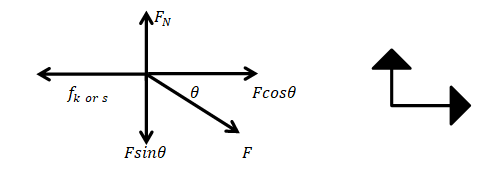
Concept explainers
In Fig. 6-12, if the box is stationary and the angle θ between the horizontal and force

Figure 6-12 Question 1.
To find:
Whether the following quantities increase, decrease, or remain the same when an applied force is directed downward at an angle
(a)
(b)
(c)
(d)
(e) And, whether the magnitude of the frictional force on the box increases, decreases, or remains the same if the angle θ is increased.
Answer to Problem 1Q
Solutions:
(a) The value of horizontal force
(b)
(c) The value of the normal force
(d)
(e) The friction force increases when the box slides and the angle between the surface and box also increases.
Explanation of Solution
Concepts
If the block slides, then kinetic frictional force is given by
Explanations:
Given Data:
In the problem (a) to (b): the box is stationary and the angle
Note: It is clear from Fig. 6-12, the angle
Formula used:
The free-body depiction for the inclined slope is provided below.
From Fig. (6-19) of the textbook and the free body diagram, we can draw:

No acceleration in the first case (from (a) to (d)) as the box is in the stationary position. Hence, acceleration is zero.
Applying Newton’s 2nd law on the y-axis:
If the block slides, the kinetic frictional force:
If it does not slide, then the magnitude of maximum static friction:
Calculations: To find the magnitude of the different forces and their nature (increasing, decreasing, or no-change) when the angle (
(a) The horizontal component of the force is
(b) If a body does not move, the static frictional force and the component parallel to the surface are equal in magnitude, and is directed opposite that component. If the component decreases,
(c) The normal component of the force is given in Eq. (1).
The normal component of the force is
(d) From Eq. (3), the magnitude of the maximum static friction will also increase as
(e) In the sliding scenario, kinetic friction force can be explained by Eq. (2). This results in an increase in the kinetic frictional force. Thus, the friction force increases when the box slides and the angle between the surface and box increases.
Conclusion
If the value of the normal force
Want to see more full solutions like this?
Chapter 6 Solutions
FUNDAMENTALS OF PHYSICS (LLF)+WILEYPLUS
Additional Science Textbook Solutions
Chemistry: A Molecular Approach (4th Edition)
Chemistry: Structure and Properties (2nd Edition)
Cosmic Perspective Fundamentals
Campbell Biology (11th Edition)
Physics for Scientists and Engineers: A Strategic Approach, Vol. 1 (Chs 1-21) (4th Edition)
Human Biology: Concepts and Current Issues (8th Edition)
- pls help on thesearrow_forward20. Two small conducting spheres are placed on top of insulating pads. The 3.7 × 10-10 C sphere is fixed whie the 3.0 × 107 C sphere, initially at rest, is free to move. The mass of each sphere is 0.09 kg. If the spheres are initially 0.10 m apart, how fast will the sphere be moving when they are 1.5 m apart?arrow_forwardpls help on allarrow_forward
- 19. Mount Everest, Earth's highest mountain above sea level, has a peak of 8849 m above sea level. Assume that sea level defines the height of Earth's surface. (re = 6.38 × 106 m, ME = 5.98 × 1024 kg, G = 6.67 × 10 -11 Nm²/kg²) a. Calculate the strength of Earth's gravitational field at a point at the peak of Mount Everest. b. What is the ratio of the strength of Earth's gravitational field at a point 644416m below the surface of the Earth to a point at the top of Mount Everest? C. A tourist watching the sunrise on top of Mount Everest observes a satellite orbiting Earth at an altitude 3580 km above his position. Determine the speed of the satellite.arrow_forwardpls help on allarrow_forwardpls help on allarrow_forward
- 6. As the distance between two charges decreases, the magnitude of the electric potential energy of the two-charge system: a) Always increases b) Always decreases c) Increases if the charges have the same sign, decreases if they have the opposite signs d) Increases if the charges have the opposite sign, decreases if they have the same sign 7. To analyze the motion of an elastic collision between two charged particles we use conservation of & a) Energy, Velocity b) Momentum, Force c) Mass, Momentum d) Energy, Momentum e) Kinetic Energy, Potential Energyarrow_forwardpls help on all asked questions kindlyarrow_forwardpls help on all asked questions kindlyarrow_forward
 Classical Dynamics of Particles and SystemsPhysicsISBN:9780534408961Author:Stephen T. Thornton, Jerry B. MarionPublisher:Cengage Learning
Classical Dynamics of Particles and SystemsPhysicsISBN:9780534408961Author:Stephen T. Thornton, Jerry B. MarionPublisher:Cengage Learning Principles of Physics: A Calculus-Based TextPhysicsISBN:9781133104261Author:Raymond A. Serway, John W. JewettPublisher:Cengage Learning
Principles of Physics: A Calculus-Based TextPhysicsISBN:9781133104261Author:Raymond A. Serway, John W. JewettPublisher:Cengage Learning University Physics Volume 1PhysicsISBN:9781938168277Author:William Moebs, Samuel J. Ling, Jeff SannyPublisher:OpenStax - Rice University
University Physics Volume 1PhysicsISBN:9781938168277Author:William Moebs, Samuel J. Ling, Jeff SannyPublisher:OpenStax - Rice University College PhysicsPhysicsISBN:9781938168000Author:Paul Peter Urone, Roger HinrichsPublisher:OpenStax College
College PhysicsPhysicsISBN:9781938168000Author:Paul Peter Urone, Roger HinrichsPublisher:OpenStax College Physics for Scientists and Engineers: Foundations...PhysicsISBN:9781133939146Author:Katz, Debora M.Publisher:Cengage Learning
Physics for Scientists and Engineers: Foundations...PhysicsISBN:9781133939146Author:Katz, Debora M.Publisher:Cengage Learning Physics for Scientists and Engineers with Modern ...PhysicsISBN:9781337553292Author:Raymond A. Serway, John W. JewettPublisher:Cengage Learning
Physics for Scientists and Engineers with Modern ...PhysicsISBN:9781337553292Author:Raymond A. Serway, John W. JewettPublisher:Cengage Learning





